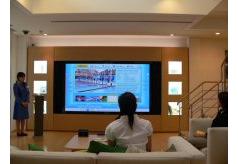Inside Panasonic's greener, smarter future home

During our trip round the Panasonic Center in Tokyo last week, it was easy to be impressed by the breadth of technology the Japanese electronics giant has at its disposal.
But tricky questions about the environmental cost of large-scale technology consumption are never far away. We're obviously impressed by Panasonic's 150-inch plasma TV. But how much does it spike your electricity bill when you turn it on?
We're all familiar with the big eco buzzwords by now - carbon footprints, greenhouse gas emissions, recyclables and sustainability. And, frankly, these concepts are far more important in the long-term than how big a TV is or how many nanobots can fit on the head of a pin.
So it was a relief to be introduced to Panasonic’s vision of a cleaner future in its Eco & UD House.
How has Panasonic gone green?
From the outside, the beige two-up two-down looks anything but a ¥100 million (£490,000) showcase for Panasonic’s green credentials. But the interior tells a very different story.
The official line from Panasonic is that the Eco & UD House is, "based on predictions regarding people's lifestyle in 2010." Crucially, it's designed to reduce CO2 emissions by up to two thirds.
Sign up for breaking news, reviews, opinion, top tech deals, and more.
According to Panasonic, the greenest features of the Eco House are its energy-saving appliances. As we saw in our previous article, simple lifestyle changes (like using greener TVs and long-lasting light bulbs) can add up to a substantial saving on your yearly electricity bill.
Who wants a Wind Seagull?
Next on Panasonic's live-greener list is better home insulation and the use of solar panels and windmills to generate electricity. Panasonic’s U-Vacua insulation – made by vacuum-packing thick foam pieces into thin silver-coated tiles that can be used anywhere – is amongst the best in the world.
If you've not encountered it before, Panasonic's Wind Seagull is a mast that combines solar and wind power generation in one handy unit. The rest of the energy-saving in the Eco & UD House comes from a domestic hydrogen fuel cell and an intelligent power management system.
The hydrogen fuel cell installed at the Eco House is nothing particularly new - pilot schemes using similar technology are already underway in Japan. But Panasonic's Home Energy Management System (HEMS) looks particularly impressive.
HEMS relies on monitoring how appliances use electricity and when they do so. A live data feed goes from a central computer to screens all over the house. This shows how much power has been drawn from the grid, what has been self-generated by the house, the cost of running individual appliances and advice on when to use devices most efficiently.
The official Panasonic line for HEMS is “from efficient energy consumption to energy generation … a new link between your home and the global environment.” But the prominence given to displaying how much money can be saved using HEMS makes it clear that saving money is at least as important for most of us.
RFID door keys and iris scanners
But Panasonic's Eco & UD House also boasts some high-tech solutions to improve a family's quality of life.
The front door is – naturally – protected by an wireless entry system.
This uses the RFID phone-based technology that’s so common in Japan now. Anyone without an authorised phone just ain’t getting in.
When we tried to sneak by the all-seeing eye, we got a blast on an alarm and were snapped by a camera mounted on the Wind Seagull mast we mentioned earlier. The Panasonic guide only let us in after showing off the incriminating security snapshot that had been beamed to her handheld.
J Mark Lytle was an International Editor for TechRadar, based out of Tokyo, who now works as a Script Editor, Consultant at NHK, the Japan Broadcasting Corporation. Writer, multi-platform journalist, all-round editorial and PR consultant with many years' experience as a professional writer, their bylines include CNN, Snap Media and IDG.